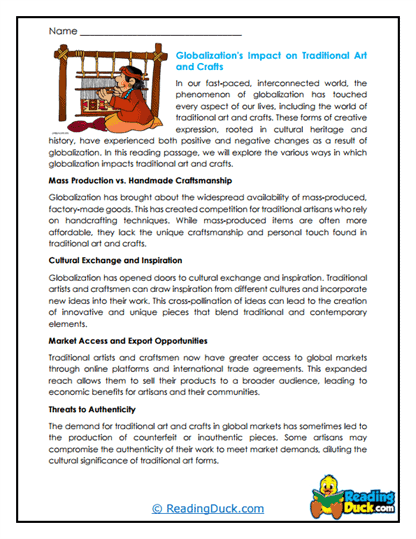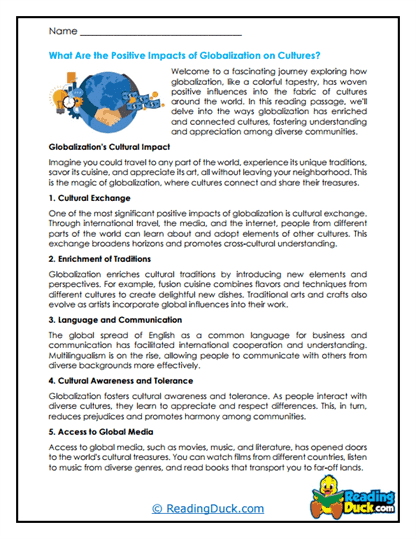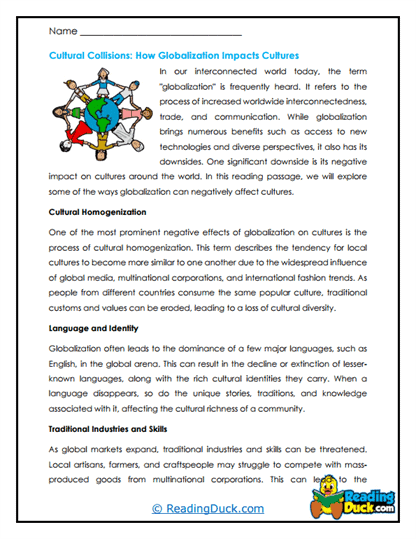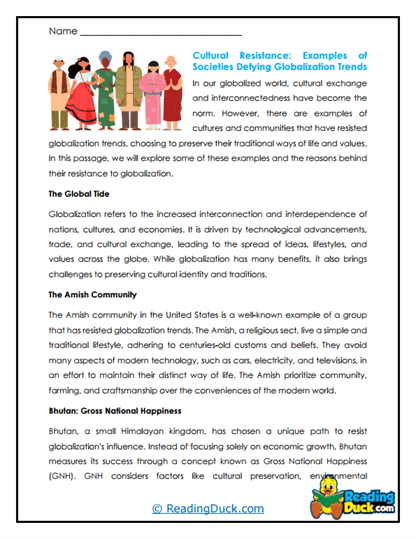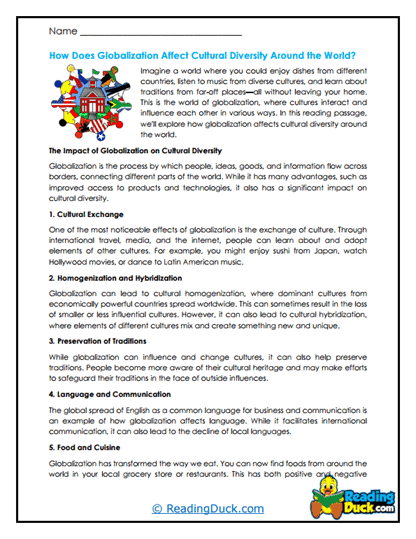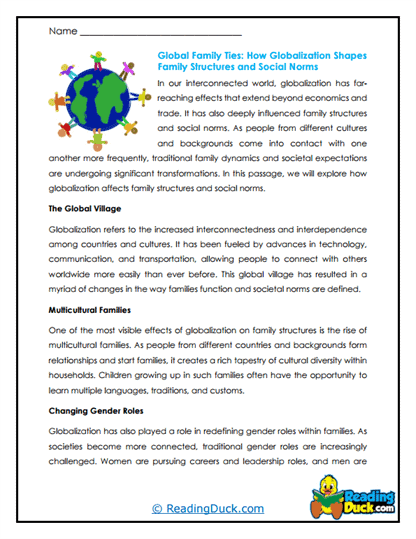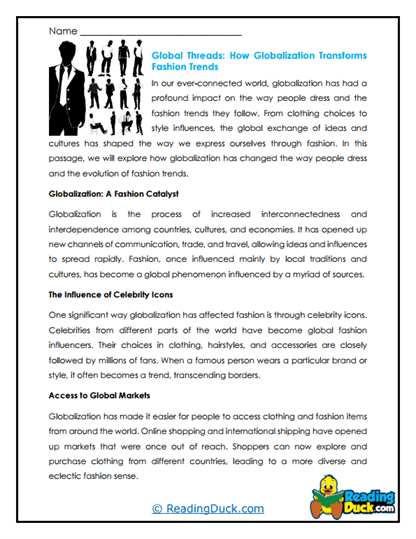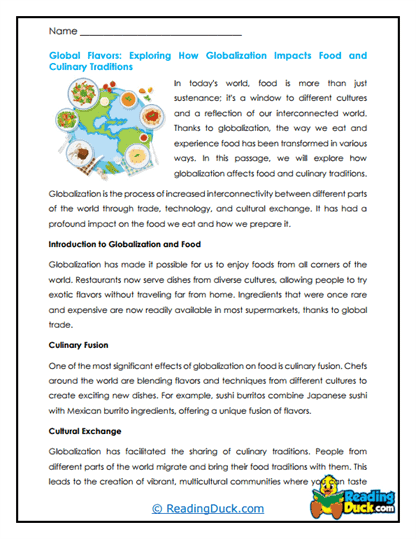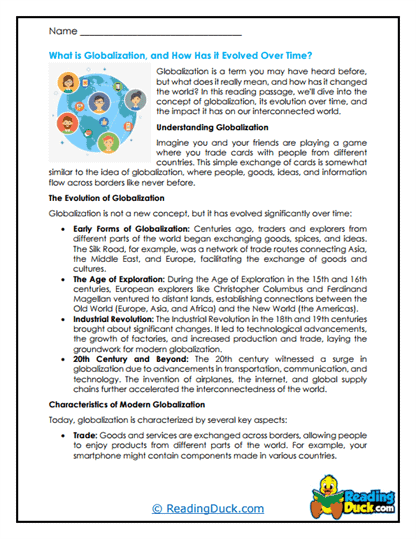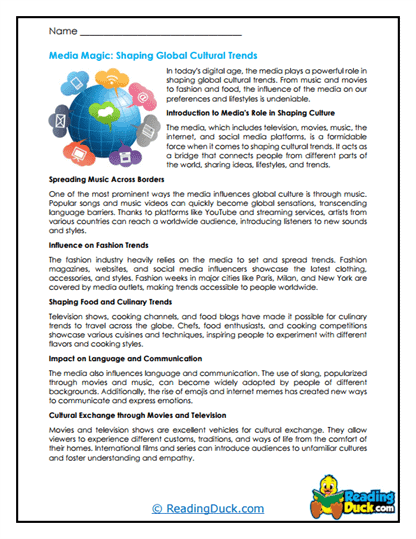Globalization Worksheets
About Our Globalization Worksheets
Our Globalization worksheets provide students with a comprehensive understanding of how interconnected our world has become. This collection explores the cultural, economic, and social impacts of globalization, helping students grasp its complexities and relevance in today's world. Designed for Social Studies, these worksheets are perfect for encouraging critical thinking and global awareness.
Each topic in this collection contains several worksheet sets that engage students through a combination of reading passages, questions, and activities:
- Multiple Choice Questions: These questions assess students’ comprehension of the reading passages, ensuring they understand the core concepts related to globalization.
- Short Answer Questions: These encourage students to express their understanding in their own words, promoting deeper engagement with the material.
- Open-Ended Questions: These questions allow students to explore their own opinions and ideas, fostering critical thinking and personal connection to the topic.
All of the worksheets come with an answer key and are available as PDF files that can be easily viewed electronically, downloaded, and printed out. They offer flexibility for both classroom and home learning environments.
Understanding Globalization: A Deep Dive into Global Interconnectedness
Globalization is a term that describes the process by which the world becomes more interconnected through the exchange of goods, ideas, cultures, and technologies. For students, understanding globalization is crucial as it affects almost every aspect of modern life, from the products they use daily to the cultural influences they encounter. When introducing globalization, it’s important to emphasize that while it brings many benefits, it also presents challenges that societies must navigate.
Key Aspects of Globalization:
- How Technology and the Internet Shape Global Culture: Technology, especially the internet, has accelerated globalization by enabling instant communication and access to information. Students explore how these advancements have created a shared global culture, yet also highlight the digital divide that persists in many parts of the world.
- Positive Impacts of Globalization on Cultures: Globalization has led to the spread of ideas and cultural practices, promoting diversity and understanding. Students learn about the benefits of cultural exchange, such as the enrichment of societies through exposure to new perspectives and traditions.
- Globalization and Languages: The spread of languages, particularly English, as a global lingua franca, is both a product and a driver of globalization. Students discuss the pros and cons of language globalization, including the potential loss of linguistic diversity and the benefits of a common language for international communication.
- Globalization and How It Evolved: Understanding the history of globalization helps students grasp its current form. This topic covers key milestones in globalization, from the Silk Road to the digital age, and how these developments have interconnected the world.
- How Media Shapes Global Cultural Trends: Media, including television, movies, music, and social media, plays a significant role in shaping global cultural trends. Students examine how media influences fashion, behaviors, and even social norms across different societies.
- How Globalization Transforms Fashion Trends: Fashion is a clear example of globalization in action. Students explore how global fashion trends emerge, influenced by cultural exchanges, media, and the global economy, and how these trends impact local identities.
- How Globalization Shapes Family Structures and Social Norms: Globalization has influenced family structures and social norms worldwide, leading to changes in traditional roles and expectations. Students discuss the shifts in family dynamics and the social norms that accompany them.
- Examples of Societies Defying Globalization Trends: Not all societies embrace globalization in the same way. Some resist it to preserve their cultural identity and traditions. Students explore examples of societies that have chosen to limit their exposure to globalization, maintaining unique cultural practices.
- How Globalization Affects Cultural Diversity Around The World: While globalization promotes cultural exchange, it can also lead to cultural homogenization. Students consider the impact of globalization on cultural diversity, including the risks of losing unique cultural identities.
- How Globalization Impacts Food and Culinary Traditions: The global exchange of food has enriched culinary traditions around the world, but it also raises questions about sustainability and the preservation of local food cultures. Students explore the global food network and its implications for local diets and traditions.
- Globalization's Impact on Traditional Art and Crafts: Traditional art and crafts often face challenges in the global market, where mass-produced goods dominate. Students learn about efforts to preserve and promote traditional arts in the face of globalization.
These topics offer students a comprehensive understanding of globalization, encouraging them to think critically about its impacts on the world. By exploring these aspects, students gain a well-rounded perspective on how globalization influences cultures, economies, and societies.
The Importance of Globalization Education
Learning about globalization is essential for students of all ages as it prepares them to navigate a world that is increasingly interconnected. Understanding the dynamics of globalization helps students appreciate the complexity of global issues, from economic dependencies to cultural exchanges. This knowledge is crucial for developing critical thinking skills, fostering empathy, and promoting informed citizenship in a globalized world.
Moreover, globalization education equips students with the tools they need to thrive in a multicultural and interconnected society. It encourages them to be open-minded, adaptable, and culturally aware—qualities that are increasingly valuable in both personal and professional settings. By understanding globalization, students can better appreciate the diversity around them, engage thoughtfully with global issues, and contribute meaningfully to their communities and the world at large.
Bringing Globalization Education into the Classroom
To make the most of the Globalization worksheets, teachers and parents can incorporate the following strategies into their teaching methods. These tips help ensure that students not only understand the concept of globalization but also see its relevance in various aspects of their lives:
- Interdisciplinary Projects: Combine Social Studies with other subjects like Economics, Geography, and Language Arts to explore globalization from multiple perspectives. For example, students can research the economic impact of globalization on different countries or analyze the portrayal of globalization in literature.
- Current Events Discussions: Use current global events as a springboard for discussions on globalization. Encourage students to relate these events to the topics covered in the worksheets, helping them connect theoretical knowledge with real-world occurrences.
- Debate and Role-Playing: Organize debates or role-playing activities where students take on the roles of different stakeholders in globalization, such as government officials, business leaders, or cultural advocates. This helps them understand the complexities and diverse viewpoints surrounding globalization.
- Cultural Exchange Activities: Facilitate cultural exchange activities where students learn about different cultures and share their own. This could include virtual exchanges with students from other countries, cultural fairs, or projects that explore global traditions and customs.
- Media Literacy Lessons: Incorporate lessons on media literacy to help students critically analyze how media shapes global cultural trends. Discuss the role of social media in spreading cultural practices and the implications of media-driven globalization.
- Field Trips and Guest Speakers: If possible, arrange field trips to cultural institutions or invite guest speakers who can provide firsthand insights into globalization’s effects on local and global communities. These experiences can bring the topic to life and offer students new perspectives.
- Creative Assignments: Encourage students to create projects that express their understanding of globalization, such as documentaries, podcasts, or artwork. These creative assignments allow students to explore the topic in a way that resonates with their interests.
- Case Studies: Use case studies to examine specific instances of globalization, such as the spread of a particular technology, the impact of a global brand on local markets, or the preservation of a cultural practice in the face of global influences.
- Global Citizenship Projects: Engage students in projects that promote global citizenship, such as initiatives to support fair trade, environmental sustainability, or cultural preservation. These projects help students apply their knowledge of globalization in meaningful ways.
- Cross-Cultural Communication Skills: Teach students about effective cross-cultural communication, emphasizing the importance of understanding and respecting cultural differences. This can be integrated into language lessons or as part of a broader discussion on global citizenship.
By implementing these strategies, educators and parents can create a rich, dynamic learning environment that deepens students' understanding of globalization. These activities not only enhance students' knowledge but also empower them to think critically about their role in a global society. Through the Globalization worksheets, students will gain valuable insights into the interconnected world they live in, preparing them to become informed, engaged, and responsible global citizens.
